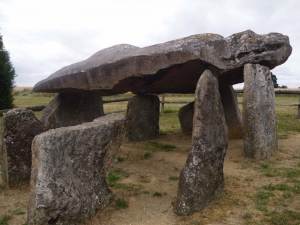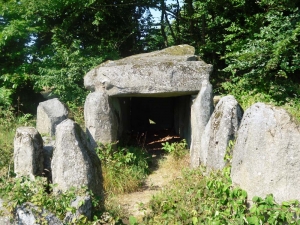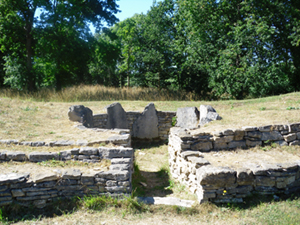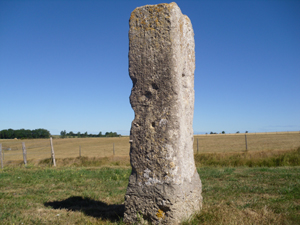|
Enigmatic
and timeless, megaliths hold secrets of prehistoric knowledge and beliefs that
we like to speculate about but will never fully decipher. To modern druids,
these stones are part of the sacred heritage that links us with our ancestors.
For historians and archaeologists, they have answered some questions but raised
many more. And throughout the ages, story-tellers and poets have found them a
source of inspiration.
Menhirs and
dolmens are to be found all over France, with a high concentration in the belt
from Brittany, down through Vendée, to Languedoc. Menhirs (Breton: ‘maen’ =
stone, ‘hir’ = long) stand singly, in pairs, or in alignments of any number
from a modest few to several thousand. The tallest in France is the Menhir
d’Avrillé in Vendée, towering seven metres above ground. Numerous theories have
attempted to explain the origins of standing stones, none totally convincing;
but it seems probable that they had ritualistic significance. Dolmens (Breton:
‘taol’, mutating to ‘daol’, = table) served as prehistoric burial chambers and
consist of upright stones with horizontal slabs across the top. There are over
4,000 dolmens in France.
You don’t
need to be a poet or an archaeologist to find megalithic monuments fascinating.
Some of the following examples are world-famous, others are relatively unknown,
but each one is located in a delightful area of western France that will beckon
visitors to explore further.
MENHIRS DE
LAGATIAR (FINISTERE)
The
Presqu’Ile de Crozon is a perfect setting for standing stones, especially with
rising sea mists lending an ethereal quality to the rugged beauty of the
landscape. Within walking distance of the peninsula’s tip at Camaret are the
Menhirs de Lagatiar. There are 84 stones on this restored site, arranged in two
lines at right-angles to each other, with the highest stone measuring about 2.5
metres.
A BRETON
CONTE
Once every
100 years, on the Day of the Stones, the Menhirs de Lagatiar bathe in the ocean
at midnight, leaving unguarded the treasure buried beneath them. The forfeit,
should men raid this treasure, is one human life. On the appointed date the
wicked Jakez took his friend and rival in love Ewen with him to steal the
treasure – taking a five-leaf clover for his own protection, and conveniently
forgetting to warn Ewen about the forfeit. When the stones returned from the
sea and demanded payment, Ewen fell to his knees in terror and prayed while
Jakez searched his pockets in vain for his talisman ... and Ewen survived to
keep the treasure and marry the girl.
LA ROCHE
AUX FEES (ILE ET VILAINE)
Dolmens
composed of a series of vertical and horizontal stones with a constant height
are known as long barrows or allées couvertes. The largest one in France is La
Roche aux Fées at Essé, near Rennes, which is nearly 20 metres long, and,
unusually, high enough inside for visitors to stand upright. To create it,
prehistoric man transported more than 40 stones, each weighing up to 45 tonnes,
over distances of at least four kilometres.
CARNAC
(MORBIHAN)
This is the
biggest and most famous megalithic site anywhere in the world, and is truly
amazing. Some four thousand standing stones extend over a distance of almost
four kilometres and are carefully arranged in four separate alignments: Menec,
Kermario, Kerlescan and Petit Menec. Legend tells us that the stones are an
army of Roman soldiers petrified by St Cornelius.
Guided
tours are available and access is restricted; see http://carnac.monuments-nationaux.fr/fr/bdd/page/visites
for details.
LES PIERRES
FOLLET (VENDÉE)
Also known
as ‘les Minches de Gargantua’, these two stones stand facing each other in the
village of Follet, near Rosnay-sur-Yon. At 3.5m and 3.66m the Pierres Follet
are dwarfs compared to some Vendéen megaliths, but they have a giant place in
French folklore. The nearby Chaos du Piquet, a site of outstanding natural
beauty, is equally steeped in legend.
THE LEGEND
OF LES MINCHES DE GARGANTUA
One of
Gargantua’s favourite pastimes was playing pétanque with boulders near Rosnay.
Although he meant no harm, his careless aim claimed many casualties amongst the
villagers, their roofs, their sheep and their cattle. The shepherds’ dogs tried
to chase the giant away, but to Gargantua the dogs’ teeth were mere
irritations, like fleabites to a cat. One day two exceptionally fierce and
persistent dogs buried their fangs in his ankles, drawing blood and refusing to
be shaken off. Gargantua hurled a massive stone at each of them, but the dogs
dodged and kept on biting until the giant fled, never to return. The two stones
remain upright, embedded in the ground at Follet, and local dogs take
particular delight in watering them.
PORNIC
(LOIRE ATLANTIQUE)
A visit to
Pornic and a stroll along its coastal path – part of the Sentier des Douaniers
that runs from Saint-Nazaire to Mont Saint Michel – provides not only
breathtaking Atlantic views but also an opportunity to inspect a trio of
dolmens: Mousseaux, Joselière and Pierre Creuse. Some ten kilometres away at
Saint-Pierre-en-Retz you can find half-a-dozen menhirs spread across three
sites (Pierre le Matz, Platènes and Chevanou), and another stands nearby at La
Riveraie.
DOLMEN DES
ERVES (MAYENNE)
The Dolmen
des Erves holds the distinction of being the oldest listed monument in the
Mayenne. During excavations at the site a pick made from deer antler was
discovered, from which scientists have established that the dolmen was
constructed during the fourth century B.C. It lies at the edge of the charming
medieval village of Sainte Suzanne, one of the Mayenne’s ‘Petites Cités de
Caractère’ and listed amongst ‘Les Plus Beaux Villages de France’.

LA TABLE AU
DIABLE (ORNE)
Near the
cemetery on the outskirts of the village of Passais-la-Conception, the Devil’s
Table is an allée couverte at the edge of a forest. A wander into the forest
brings you to more megaliths and perhaps an ideal picnic spot on a hot day.
Passais is one of the villages featured in the discovery trail ‘Au Pays de
Lancelot du Lac’, a 120-kilometre circuit created around places in Manche, Orne
and Mayenne with Arthurian connections.

LES PIERRES
POUQUELEES (MANCHE)
This allée
couverte nestles amongst gorse and bracken on a remote, often windswept plateau
high above Vauville, on the Cap de la Hague promontory. The steepish climb to
reach the spot rewards you with panoramic views across the immense sandy bay
far below, sweeping away towards Cap de Flamanville. A plaque beside the
monument relates how, in the 1830s, locals stole stones to build a bridge, but
were compelled by the authorities to return them.

COLOMBIERS-SUR-SEULLES (CALVADOS)

Two
megalithic sites stand along the D176 just outside Colombiers-sur-Seulles, a
small village near Caen. One is a tumulus (a barrow, or burial mound), a rare
and impressively elaborate construction that has recently been developed into a
visitor attraction. The other monument, the Menhir des Demoiselles, is not
signposted but can be found at the roadside at the entrance to Colombiers. The
name of the stone, and its curious indentations, are explained in local legend.

HELP FOR
DAMSELS IN DISTRESS?
It has been
suggested that menhirs were ancient fertility symbols. There are several
legends linked to this supposition, one of which concerns the Menhir des
Demoiselles at Colombiers. It was said that if maidens looking for a husband,
or bachelors looking for a wife, climbed up this stone and placed a coin on the
top, they would be married within twelve months. Although the menhir is only
two metres high, clambering up would require a certain amount of effort; and
one must assume that fear of the resident deity prevented casual passers-by
from helping themselves to the coins left by the young hopefuls.
© Copyright
| 


